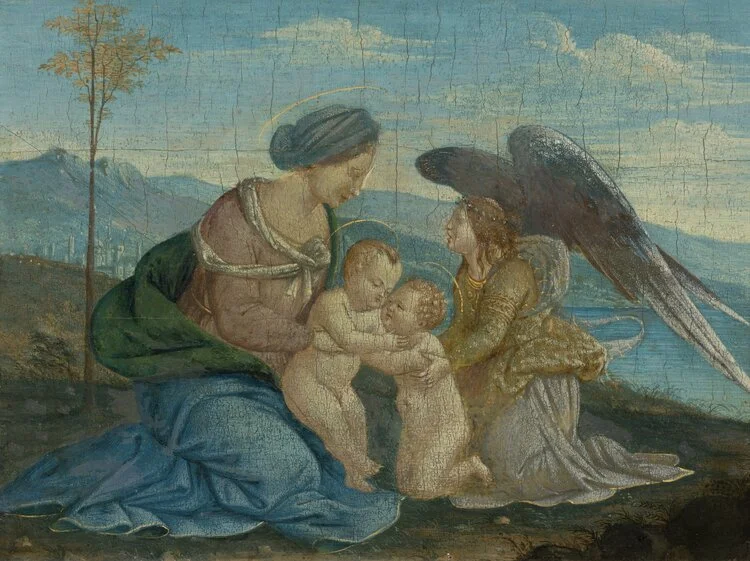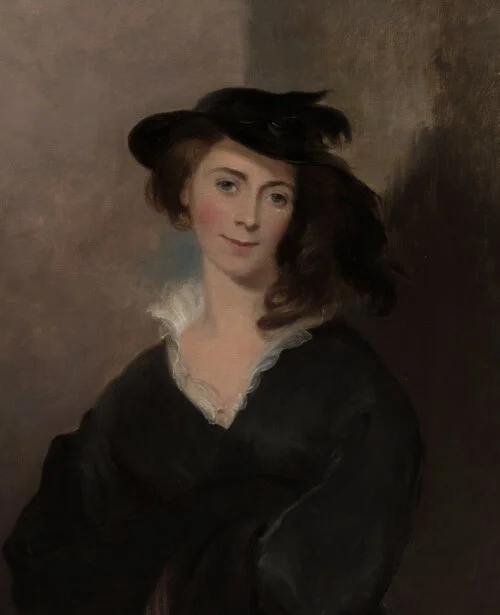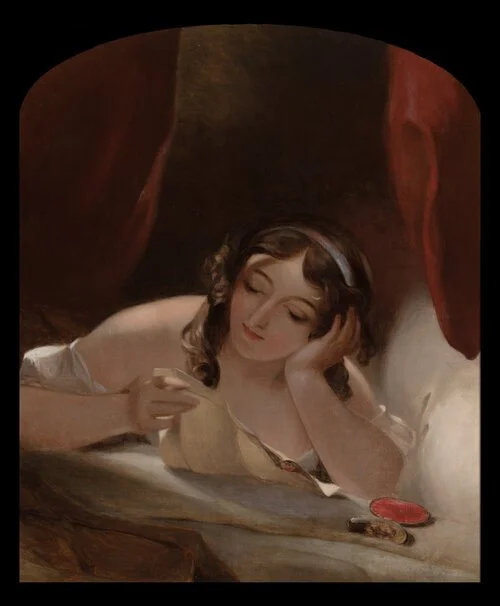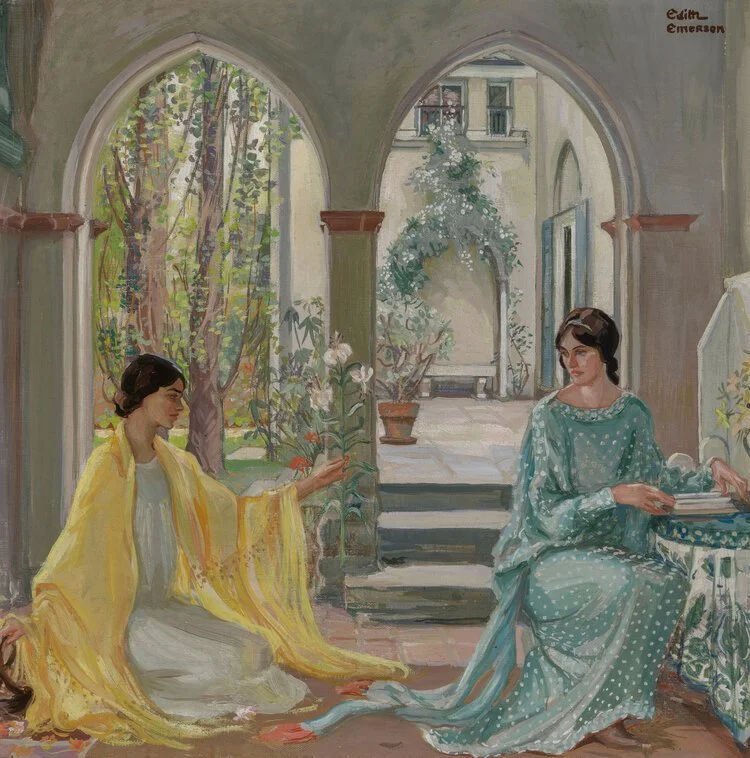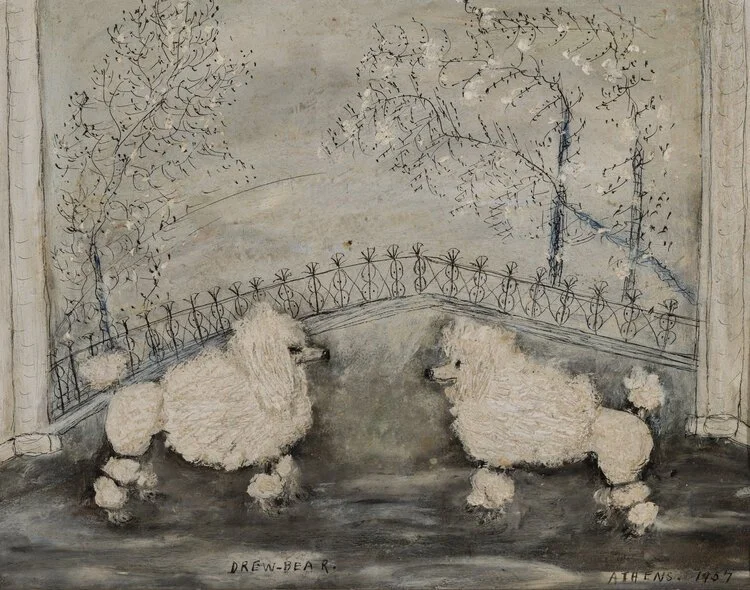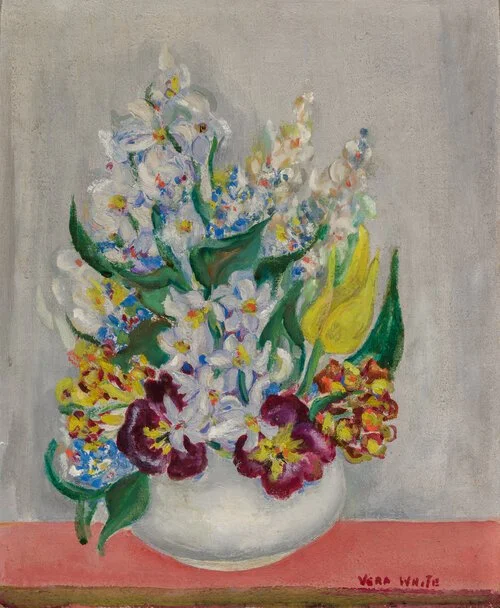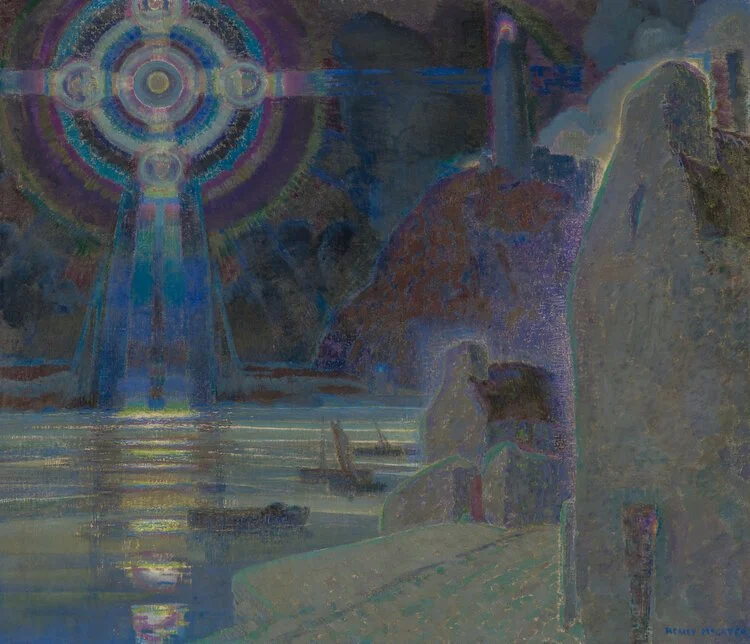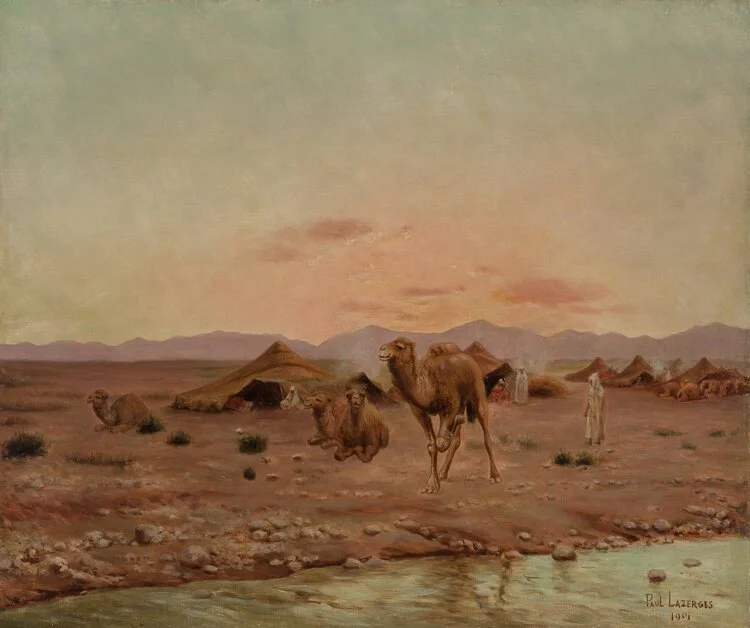Highlights from the Collection
Glen Foerd’s unique collection shows an eclectic range in style and period. Collected primarily by Caroline Foerderer and her daughter Florence Foerderer Tonner, this group of paintings brings together work from the Renaissance to the twentieth century that would have never been in conversation otherwise.
The collection began with a large purchase of works by great masters of religious art, landscape painting, and portraiture, in 1899, shortly after the Foerderer family acquired the Glen Foerd estate. Florence Foerderer Tonner continued to collect new work until the end of her life in 1971, adding variety and modernity to the collection. She favored works on paper and artists local to Philadelphia, many of them women. A number of the artists Florence supported were challenging social norms or fighting for representation in a predominantly male field, while other paintings within the collection were created by women like her, who dabbled in art alongside their passion for patronage.
In the art gallery today, a fifteenth century Venetian sits next to a painting of mirrored standard poodles by a self-taught artist. Random? Maybe. Nevertheless, these extraordinary works demonstrate a breadth of artistic backgrounds, influences, and movements that make Glen Foerd’s collection an endless source of curiosity and inspiration.

Learn More about the Collection
Educated in both Scotland and Italy, Allan Ramsay was internationally celebrated for his portraits. After establishing a successful studio in London, he was appointed the “Principal Painter in Ordinary” by King George III.
This painting is a three-quarter length version of the official portrait of Queen Charlotte at Buckingham Palace. She is depicted in the robes she wore at her Coronation in 1761. The King commissioned so many copies of this and other official State Portraits for friends, relations, fellow sovereigns and state representatives, that Ramsay’s showroom was littered with canvases of this portrait in different sizes and stages of completion.
Ramsay turned to a career in essay writing when an injury to his right arm in 1773 ended his painting career. By 1784, Sir Joshua Reynolds was appointed “principal Painter in Ordinary,” followed by Sir Thomas Lawrence in 1792.
Queen Charlotte, date unknown
Allan Ramsey, ca. 1713 - 1784
England
Lady Trimelston, date unknown
Sir Thomas Lawrence, ca. 1769 - 1830
England
Sir Thomas Lawrence was a remarkable artist from early childhood. By the age of ten, Lawrence’s portraits were the main source of income for his family. Largely self-taught, Lawrence rose to be one of the leading portrait painters of the nineteenth century, known for an evocative style that would eventually be classified as romanticism. Rosy-cheeked Lady Trimelston, with green parasol in hand and colorful shawl cascading down her back, is youthful and ready for a stroll in the garden, at what appears to be golden hour.
Note the painstaking detail in the transparency of the lady’s puffed sleeve and the sheen of her white shoes. Employing a polished, flattering style to his portraits, Lawrence puts great attention into rendering fabric. He believed satin, above all other clothing, provided “soft rich folds and infinitely varied lights and shadows” that enriched his final portraits.
The Love Letter, 1861
Thomas Sully, ca. 1783-1872
United States
“The Love Letter” shows Sully’s capacity to build narrative and character, evoking a sense of vulnerability and longing within the scene. Thomas Sully made several versions of this painting, starting in 1834.
In addition to his extensive work as a portrait artist, Sully had a strong interest in theatre, having been raised by a family of theatre producers. He began to create paintings that centered performance and literature in the late 1830s when his portrait commissions were slowing down. Through its illustrative title, expressive sitter, and the locket featuring an image of the woman’s lover that accompanies her while reading, “The Love Letter” builds a story that might be considered a precedent for his later theatrical painting.
Head of a Young Woman in a Black Feathered Hat, date unknown
Thomas Sully, ca. 1783-1872
United States
Thomas Sully was a British-born artist who came to Philadelphia in 1792. Inspired by the work of his mentor, Sir Thomas Lawrence, Sully employed a romantic, fluid style to his paintings. He quickly rose to be one of the most renowned portratists of his generation, painting portraits of Thomas Jefferson, Queen Victoria, and John Quincy Adams, among other dignitaries.
Although he painted many of the most prominent political figures of his day, he was most sought after by fashionable society women. He was known to produce idyllic, elegant, and sometimes exaggerated portrayals of his sitters. Over the course of Thomas Sully’s career, he would paint around two thousand portraits. According to one critic, Sully’s portraits of women were, “oftentimes poems, full of grace and tenderness...enough to satisfy even a husband or a lover.”
Camel Drivers - Desert Encampment at Dawn, 1901
Jean-Baptiste-Paul Lazerges, 1845-1902
France
Jean-Baptiste-Paul Lazerges was trained by his father Hippolyte, a well-known orientalist painter, who often portrayed subjects and scenes from North Africa. Orientalism derives from the word "orient," meaning "East." Painters working within an orientalist tradition in the 1800s often traveled from Europe to destinations considered exotic and wild by comparison. Edward Said, a social theorist from the late 20th century, wrote extensively about the problems with this way of seeing the world, declaring that orientalism "enables the political, economic, cultural and social domination of the West, not just during colonial times, but also in the present."
Jean-Baptiste-Paul Lazerges travelled to Egypt and Tunisia and spent longer stays in Algeria, which was colonized by his home country of France at the time. This desert scene shows a fascination for camels, a subject notably difficult for European artists to paint, as well as the people who depended on them for transportation. The artist has put so much attention and detail into the depiction of these animals that they almost appear to float within the scene.
Norfolk Landscape, date unknown
James Stark, ca. 1794-1859
England
James Stark was an English landscape painter. Though he enjoyed a great deal of success in his London studio, an illness forced him to return to his birthplace of Norwich, where he eventually became president of the Norwich Society of Painters. He devoted himself to painting local landscapes, and gave a great deal of attention to the Norfolk rivers.
This painting celebrates Norfolk village life in all of its stages. A pale, decaying tree trunk stands at the center, leafless and split, but surrounded by lively animals. A dog swims towards five ducks in the river, who fly up, startled. A hunter in blue watches the chase from a fence. A group of sheep stand at the edge of a path that leads to a wood, where two figures are walking. The river runs through the foreground and to the left, leading the viewer to note pastures, a windmill, clouds and blue clearings in the background.
Stark’s style was influenced largely by his mentor John Chrome, a fellow Norwich painter of renowned romantic landscapes that captured the atmosphere of natural scenes using loose brushwork. He also drew inspiration from seventeenth century Dutch masters like Jacob van Ruisdael, from whom he often borrowed strategies of composition.
Edge of a Wood, date unknown
John Constable, ca. 1776-1837
England
John Constable was born in Suffolk, England. As a child he often travelled the countryside surrounding his home on sketching trips. These landscapes later became a focus for much of his artwork.
Constable drew inspiration from French romantics and Dutch landscape painters, and developed his own personal style by using broken brushstrokes in order to achieve glistening or seemingly moving light. Believing that landscape paintings should be drawn directly from nature, he deviated from the dramatic, idealized approach of his contemporaries. Though he did not achieve much success in his lifetime, Constable’s unique use of light would become an early influence on the Impressionist movement.
Unknown Title, date unknown.
Henry Bainbridge McCarter, 1864-1942
United States
Henry Bainbridge McCarter was an American illustrator and painter who influenced modernist painters in Philadelphia through his post at the Pennsylvania Academy of Fine Arts (PAFA), where he taught for over forty years.
At the age of 15, McCarter began his studies at PAFA, where he learned from the renowned realist painter Thomas Eakins, among others. But McCarter didn’t find true belonging in an artistic community until he pursued further studies in France, where he eventually apprenticed with post-impressionist Toulouse Lautrec.
This painting showcases the artist’s emphasis on symbolic content, with penetrating color shooting forth from a cross. These beams outshine a lighthouse that stands above a waterfront and illuminate ripples in the water, creating a scene that is bursting with vibrance.
In 1902, McCarter returned to PAFA as an instructor, teaching courses in illustration and painting to notable students like Charles Demuth. A talented illustrator, McCarter chose to concentrate on painting in oils and watercolor from the 1920s onward.
Village and Calvary, 1949
Luigi Settanni, 1908-1984
Italy
When Luigi Settanni moved to the United States in the 1920s, he enrolled at the Philadelphia Museum School of the Industrial Art, which is now the University of the Arts. He also studied at the Barnes Foundation and earned a Barnes scholarship to travel.
This work bears resemblance to paintings within the Barnes' collection that Settanni created in Pont l'Abbé, Brittany, in the northwestern region of France. The red-skirted figure on the left side of the painting is a tell-tale sign that we are in Brittany here as well, donning the traditional white lace hat of the region, or coiffe bigoudène, which stands tall on her head. The artist draws attention to the stone masonry of the village architecture and roadside walls using flat brushwork and fine-pointed contours in bold colors, a combination of mark-making and palette that shows influence from expressionistic and Fauvist artists like Chaim Soutine and Henri Mattisse. Beside a small church on the right, one can see a calvary, representing the crucifixion of Jesus Christ, surrounded by a number of abstract figures.
Portrait of Willian Thomas Tonner as a Young Man, date unknown
Violet Oakley, ca. 1874-1961
United States
Violet Oakley was one of the most prolific artists of her generation. Trained by the great illustrator Howard Pyle, Oakley got her start in illustration, and went on to create public works that brought her high renown. Among her most famous commissions are her murals at the Pennsylvania State Capitol Building, which depict historical scenes with intentional inclusion of underrepresented perspectives and an idealist Victorian aesthetic. Aiming to highlight principles of tolerance and social justice within William Penn’s dream for Pennsylvania, Oakley used this commission to paint themes of unity and peace, as well as gender and racial equality.
While Oakley is most well known for her colorful, large scale works like the Pennsylvania Capitol, she sustained herself on commissions of all kinds, including portraits like this one. William Thomas Tonner was Florence Foerderer Tonner’s husband, here seated in a wicker chair against a cloudy sky with seagulls, looking both approachable and elite. Although less grand than her larger commissions, the portrait still showcases Oakley’s romantic realism through its expressive background.
Portrait of Florence Foerderer Tonner, date unknown
Violet Oakley, ca. 1874-1961
United States
Violet Oakley found a reliable patron in Florence Foerderer Tonner, and the two wrote to each other as friends. In this portrait, Florence is romantically windswept, with great attention put into the drape of her clothing and her confident, nonchalant expression.
Oakley participated in the founding of numerous arts organizations in Philadelphia that Florence Foerderer Tonner frequented, including the Plastic Club and the Philadelphia Art Alliance. Oakley also took part in informal support systems of collective living that became a source of intrigue for the public. Oakley, Elizabeth Shippen Green, and Jessie Wilcox Smith became known as the “Red Rose Girls” when they all lived together in the Red Rose Inn in Villanova. Their nickname was given by Howard Pyle, who encouraged the women to remain unmarried and pursue their artistic careers.
Joy Followed by Tears, date unknown
Violet Oakley, ca. 1874-1961
United States
This watercolor by Violet Oakley is one of the more recently uncovered objects in Glen Foerd’s collection. It was restored in 2012 after being discovered in a locked closet. While Oakley’s celebrated portraits and monumental history scenes demonstrate her mastery of composition and precision, this watercolor painting gives a sense of action and movement achieved by confident mark-making within a much shorter time frame. The title, “Joy Followed by Tears,” suggests an eruption of feeling captured beautifully by the fluidity of watercolor, beading up and streaking across the dark paper.
The waterfront scene and voluptuous clouds depicted here may have been a source of inspiration while the artist was traveling, or the watercolor could have served as a study for a larger piece. Oakley traveled extensively for political and diplomatic convenings that she was involved in as a participant or as a hired artist, and was often accompanied by her partner, Edith Emerson. This painting bears some resemblance to other works by Oakley and Emerson painted around Lake George in Upstate New York, when the two artists organized summer lectures at Elizabeth Island.
Sea Creature, 1903
Sarah Stilwell Weber, 1897-1939
United States
Sarah Stilwell Weber was born in Concordville, Pennsylvania and spent her life in the region. Like Violet Oakley, Stilwell Weber was a student of Howard Pyle, the founder of American illustration. Following her coursework at Drexel, Weber won a scholarship to study at Pyle’s residential art program. She was also a member of the Plastic Club, a women’s art organization that focused on the exhibition and promotion of visual arts.
Weber was a remarkably accomplished illustrator, and often adjusted her style to cater to the needs of her clients. Her portfolio ranged from lighthearted scenes of childhood joy to pictures that captured the spirit of Art Nouveau, with organic, winding linework around glamorous modern women. This painting enters the realm of fantasy, illustrating the poem, “The Mer-Mother” by Richard Le Gallienne, for Harper’s Magazine. The image was arranged alongside the words “And with a comb of deep-sea pearl she combed, like any other girl, her golden hair.”
The Madonna Lily, date unknown
Edith Emerson, 1888-1981
United States
Originally from Ohio, Edith Emerson was immersed in art education and travel from an early age. When she was only twelve years old, she took courses in architecture at Cornell University and also attended the Art Institute of Chicago in her early teens. But it was her classes at the Pennsylvania Academy of Fine Arts (PAFA) that made the most lasting impression. There, Emerson took a mural painting class taught by Violet Oakley, the notable artist who eventually became Emerson’s mentor, collaborator and romantic partner.
Violet Oakley’s influence is clear in this painting in its expression of narrative and attention to detail across the entire picture plane. We don’t know much about the story behind The Madonna Lily, but the painting offers us a few cues to question. What does the Madonna Lily represent, presented here by one female figure to another? Is there any significance to their positioning, with one character seated on the floor, and another in a chair? The painting seems to capture a moment in a tale, with its dreamlike figures and courtyard setting, each woman framed by a pointed arch.
Emerson honed her skills as a muralist, painter, writer, and illustrator while also devoting herself to Oakley’s studio practice and Philadelphia’s artistic community. She regularly wrote for the The American Magazine of Art and lectured at local schools as well as artist spaces. Edith Emerson served as the vice-president, president and curator of the Woodmere Art Museum from 1940 to 1978. Following her partner’s death in 1961, she created the Violet Oakley Memorial Foundation to keep Oakley’s memory and ideals alive.
Flowers and Fruit, date unknown
Hobson Pittman 1899-1972
United States
In addition to the appreciation for his artistry, Pittman was a celebrated teacher. He taught painting at Pennsylvania State and was asked to teach at the Philadelphia Museum of Art. In 1948, Pittman was elected to teach at the Pennsylvania Academy of the Fine Arts in Philadelphia. In addition to numerous prestigious awards throughout his lifetime, Pittman was honored by the Pennsylvania Academy of the Fine Arts with the title Distinguished Artist of Pennsylvania. Throughout his teaching career, he was known to have a talent for aiding a student's development without leaving his own imprint.
The Letter (Poppies in Vase), ca. 1950
Hobson Pittman 1899-1972
United States
Hobson Pittman declared, “nature can and does suggest endless ideas: color, light, shape, form, movement.” Known for his expressive oil paintings and watercolors, Pittman was able to bring life and movement to his still-life paintings. He believed anyone could copy nature verbatim, but it took a true artist to use memory and imagination in translating nature onto canvas.
Pittman moved to Philadelphia in 1915 at the age of sixteen. He studied at Penn State University, Carnegie Institute of Technology in Pittsburg, and Columbia University. He spent his summers working and living in the artist colony in Woodstock, NY, and spent time living, studying, and painting in Europe.
Cherry Trees - Mediterranean landscape, date unknown
Isabel Branson Cartwright, 1885-1966
United States
Isabel Branson Cartwright attended the Philadelphia Design School for Women, and won the 'Alumnae Award' in 1906, which allowed her to travel abroad to study for one year.
This painting showcases the warmth and vibrance of the Mediterranean region, illustrating a village hillside with cherry trees in full bloom, sloping down towards the sea and a valley filled with white stucco houses. The spindly trees create jagged shadows on the ground over bright green grasses and rounded dirt paths.
A few years following her return to the United States, Cartwright got married and moved to Texas, where she eventually held solo exhibitions in San Antonio and Fort Worth. After her husband died she returned to Philadelphia and joined The Philadelphia Ten, a group of women artists organizing and exhibiting together. Their solidarity functioned as a strategy towards collective growth in a restrictive, male-dominated art world. She participated in all 65 shows held by the Philadelphia Ten.
Chinese Wall - Philadelphia, 1952
Andrew Theis, 1924-1984
United States
Andrew Theis created this painting while a student at the Pennsylvania Academy of Fine Arts, located not far from the site depicted in the image. Theis received honors from PAFA, and a scholarship to attend the Skowhegan School in Maine.
The painting records a downtown Philadelphia scene just a year before the so-called “Chinese Wall,” or Filbert Street Viaduct, was demolished, a move that would lead to developments that dramatically changed the feeling of the city. The viaduct was considered an unsightly barrier in the mid-twentieth century, physically and socially. It’s been suggested this feature might be the source of the phrase “the wrong side of the tracks,” as many considered anyplace North of the wall an undesirable place to live, work, or engage in commerce. The wall’s short stone arches discouraged traffic to the Northern side, demonstrated here by the dull parking lot in the foreground. Philadelphia bustles in the distance, with gusts of train smoke leading up to the great City Hall Building.
The removal of the viaduct made way for the building of Penn Center and other tall skyscrapers on the West Side of Center City, as well as the creation of John F. Kennedy Boulevard, and eventually, another significant barrier: the Vine Street Expressway.
Flowers in Gold Vase, date unknown
Mary Elizabeth Price, 1875 -1960
United States
Mary Elizabeth Price once declared, “there’s nothing like creating your own competition.” Price dedicated herself to building community and mutual support with her female contemporaries. She was a member of the Philadelphia Ten, a group of women painters and sculptors who worked and exhibited together as a strategy towards collective growth in a restrictive, male-dominated art world. Price also lectured to women's groups, showcasing artworks by her esteemed friends in her presentations to heighten their visibility. She also founded the nationally recognized Neighborhood Art School for children in New York City, and from 1920 to 1927, she chaired National Associations of Women Artists.
Price was greatly influenced by religious painters of the Italian Renaissance and chose to incorporate gold and silver leaf into her colorful canvases. In this painting, a simple table setting is made to look monumental against the artist’s signature metallic background. An arrangement of warm-colored dahlias, blue larkspur, and other flowers sits between two candlesticks on a textured tabletop. In the 1920s, Price moved permanently to Bucks County, where she tended a large garden of wildflowers, her most frequent painting subjects.
The Virgin and Child with the Infant St. John the Baptist, date unknown
Girolamo da Santa Croce, ca. 1480-1556
Italy
Girolamo da Santacroce was born in Bergamo, but was active in Venice for most of his career. He was a pupil of Gentile Bellini, and continued to work in Bellini’s workshop after the great artist’s death.
This painting’s color pigments have deteriorated over time, but in its original state, the reds, blues, and greens showcased quintessential Venetian vibrancy. The landscape background and clear blue mountains are also typical of the region and period, as well as the religious motif.
Madonna & Child & Children, 1951
Jessie Drew Bear, ca. 1877 - 1962
United States
Jessie Drew Bear was born in England under the reign of Queen Victoria. Before she turned thirty, Drew Bear did the unimaginable. She moved to Philadelphia without her husband, opened her own business, and brought along her three children, whom she would raise as a single parent.
In 1905, Drew-Bear opened the London Flower Shop, which she owned and operated for more than 40 years. She was known for her skill for arranging high-end bouquets and was often chosen to provide flowers for Philadelphia’s gala events and parties. Already a successful business woman, Drew Bear began her career as an artist at 60. Receiving a paint set from her daughter, Drew Bear began painting in the studio above her flower shop. She would go on to have a vibrant career as an artist.
Phaedra, Hippolytus & Angel in Naïve Style, date unknown
Jessie Drew Bear, ca. 1877 - 1962
United States
Jessie Drew Bear was a largely self-taught artist, and in reference to her artistic style she referred to herself as a “sophisticated primitive.” She painted the things that made her happy. She would blend fantasy and imagination with personal memories and humor, creating pieces that were unlike the work of any of her contemporaries.
Although the figures in this scene are dressed in medieval wares, the story of Phaedra and Hippolytus goes back to ancient Greece. There are several versions of the story, but all include Phaedra’s tragic lust for her stepson, Hippolytus. The most common legend states that Hippolytus was killed after rejecting Phaedra’s advances. Phaedra, offended by this dismissal, sought revenge by constructing a different scandal. She told her husband that his son had raped her, leading to Hippolytus’ death. While many paintings illustrate this story at the height of its conflict, Jessie Drew Bear decided to highlight Phaedra’s intense feelings for Hippolytus at her moment of admission. Here, she delivers a love note, surrounded by swirling pink flowers and accompanied by cupid. Drew Bear’s depiction, perhaps ironic, gives no indication that something sinister is to come.
Throughout her career, Jessie Drew Bear’s style continued to develop and shift. She would go on to gain a very sophisticated understanding of art history, form, and technique, but resisted any specific genre.
Athens, 1957
Jessie Drew Bear, ca. 1877 - 1962
United States
Jessie Drew Bear’s art career began at sixty and lasted the remainder of her life. The success of her flower shop allowed Drew Bear to travel extensively and continue with her self education. She would pack her paint supplies and rent an apartment for several weeks or months in Europe, South America, or Central America. She would travel with friends or alone with her beloved dog, Mignonne. At 70, she took up scuba diving.
Despite the playful nature of her work and her lack of professional training, Jessie Drew Bear approached her art career with a great deal of seriousness, actively seeking gallery representation and exhibit opportunities. Her work was exhibited in prominent Pennsylvania institutions and she had solo shows at the Philadelphia Art Alliance and the Pennsylvania Academy of Fine Art.
Drew Bear’s adventures were often incorporated into her artwork. She would continue to explore new places and activities until the day she passed away.
Flowers in White Vase, date unknown
Vera White, 1888-1966
United States
Vera White and her husband Samuel were passionate art collectors and supporters of the artistic community. Alongside her patronage, Vera White also pursued her own art making. She exhibited drawings and paintings in solo and group shows internationally, and became known for her simple but expressive depictions of flowers.
In this painting, a round white vase holds a number of white flowers that blend into the background. More colorful blooms and leaves decorate the bottom of the bouquet, and draw the eye towards the base of the painting, showing a simple surface in pink.
White’s own work is included in the collections of the Whitney Museum of American Art, and the collection that she and her husband put together over fifty years is housed at the Philadelphia Museum of Art.
Madonna and Child, date unknown.
Anna Coleman Ladd, 1878-1939
United States
This bronze plaque by Anna Coleman Ladd shows a seated Madonna and Child under a gothic pointed arch. At the base, an inscription reads, “Ave Maria Gratia Plena,” meaning, “Hail Mary, Full of Grace.”
The Philadelphia born Ladd studied sculpture under masters in Rome at the beginning of the twentieth century. Upon her return to the United States, many prominent women in society commissioned sculptures and portraits from her, including Florence Foerderer Tonner. A relief depicting Florence holding her young daughter Marjorie can be found above the mantel of the second floor study. While her beautiful pieces resided in many stately homes, her greatest work was born from the destruction of World War I. With the help of the Red Cross, Ladd opened the Studio for Portrait Masks in Paris where she worked with clay, plasticine, and copper to provide cosmetic masks for soldiers who had been badly injured. Giving each mask the time, care, skill, and attention to detail that was so sought after by State-side socialites, Ladd created pieces that returned a sense of self and dignity to men who had suffered greatly fighting in the Great War. In 1932, the French Government honored her as a Knight of the Legion of Honor for her prosthetic work.
Wedding Cup, date unknown
Unknown artist
Germany
This wedding cup was used by Marjorie Tonner and Willam B. Gold in 1942. Marjorie was the daughter of Florence Forderer and William Tonner.
The legend of this bridal cup can be traced back to 15th-century Nuremberg. A nobleman did not approve of his daughter's love for a goldsmith. He challenged the goldsmith to make a chalice that two people could drink out of without spilling a drop.
The father assumed that would be an impossible task; however, the goldsmith crafted a woman whose skirt was hallowed out to serve as a cup and a swiveling bucket held above her head to serve as the second cup. The couple married, and the cup became a symbol of love, faithfulness, and good luck.
Flowers on Gold, 2003.
Peter Paone, b. 1936
United States
Peter Paone (b. 1936) was born and raised in Philadelphia and has had a remarkable career spanning seven decades. He studied at the Philadelphia Museum School of Art (now the University of the Arts).
In 1980, he established PAFA’s printmaking department, where he taught for 30 years. He also taught at Pratt Institute in New York, The National Academy of Design in New York, The Barnes Foundation, and The Pennsylvania Academy of the Fine Arts in Philadelphia. His work has been featured all over the U.S. as well as in London, Germany, and Austria.
Mascara, date unknown.
Helena Rubinstein, 1872-1965
Poland
Mascara of the 20th century. The mascara we know was not invented until 1852 by Rimmel. Before that, it was composed of a kohl-based product similar to eyeliner.
The brand pictured here was started by Helena Rubinstein, a Polish immigrant. She launched her beauty empire first in Europe and quickly spread to America in 1915. By the time Helena died in 1965, she was one of the richest women in the world.
*Research for this project was completed by Marygrace Kennedy. We also thank Ryan Reaves-Piercy for their work on the online exhibition.



